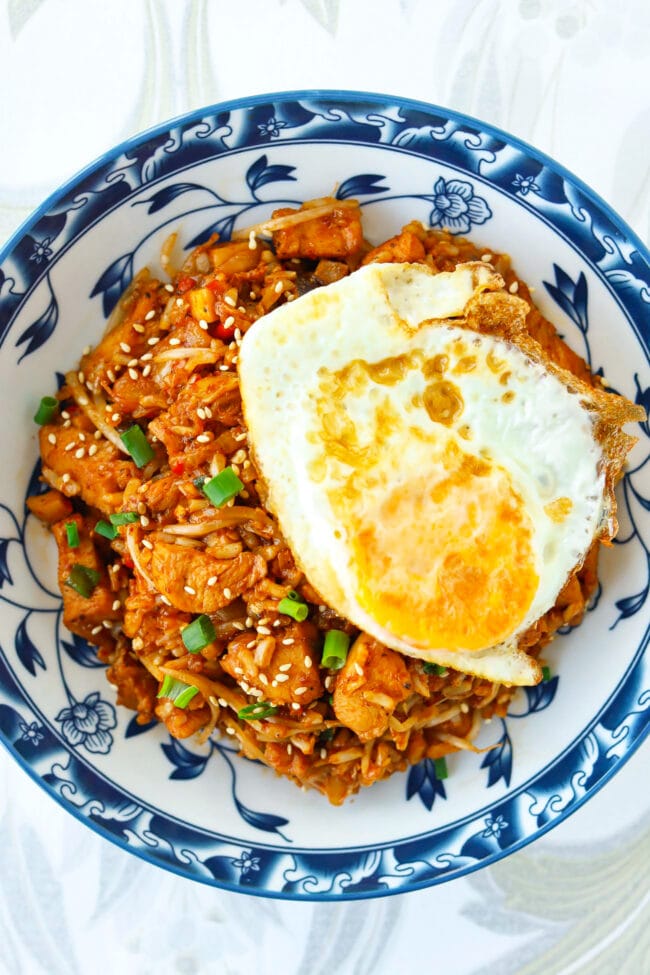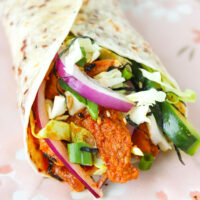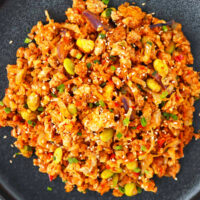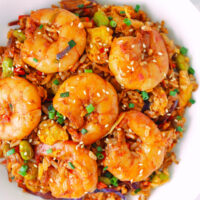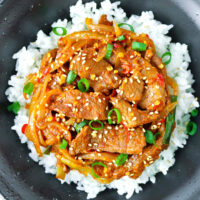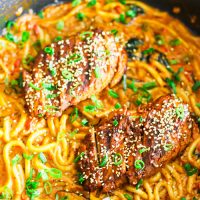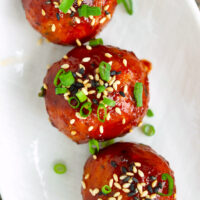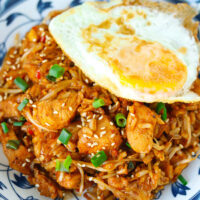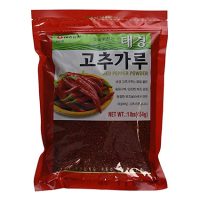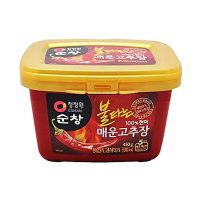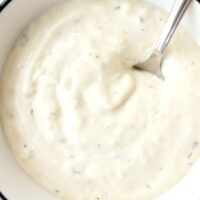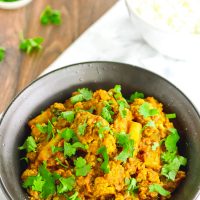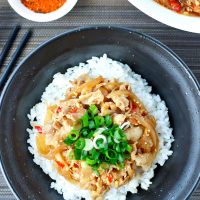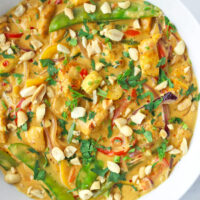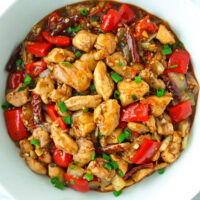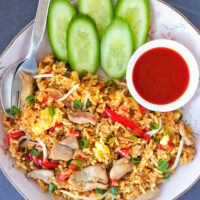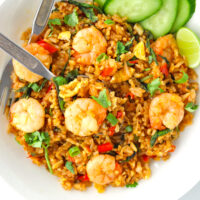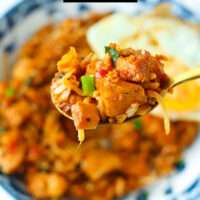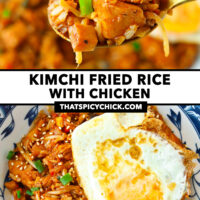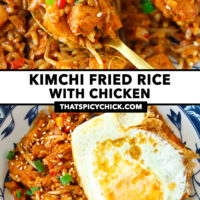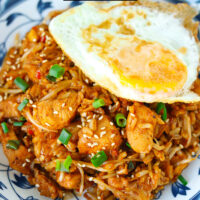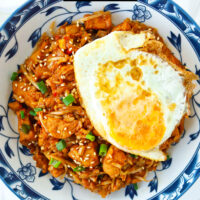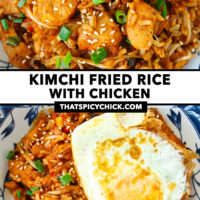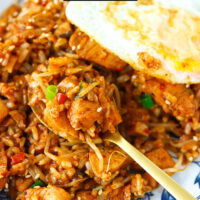Kimchi Fried Rice with Chicken
This post contains affiliate links.
Kimchi Fried Rice with Chicken is easy to make in one wok and full of BIG and BOLD flavors! This Korean fried rice is made with savory tender chicken pieces, tangy kimchi, fragrant aromatics, veggies and the most delicious gochujang infused spicy, smoky, and tangy sauce with a hint of sweetness! Ready in 30 minutes, it’s the perfect tasty meal for busy weeknights!
Kimchi fried rice (kimchi bokkeumbap) is one of my all-time favorite easy weeknight meals. It’s quick and easy to prepare and jam-packed with flavor!
This Kimchi Fried Rice with Chicken is made with seared tender chicken pieces, fragrant aromatics like garlic, ginger and fresh red chilies, meaty king oyster mushrooms, tangy cabbage kimchi, fluffy rice grains, crisp mung bean sprouts and fresh spring onion. Everything gets tossed in a savory, spicy and smoky sauce with a hint of sweetness. Topped with a crispy fried egg to finish, this is a super tasty fried rice!
This hearty Korean fried rice makes a well-rounded meal with the combination of protein, carbohydrate and vegetables. Not only is it delicious, it is a satisfying and nutritious meal on any given day.
All you need is one wok (or pan) and you can have kimchi fried rice with chicken on the table in a matter of minutes! The complex flavors will make your taste buds sing and I think you’re going to love it!
You can enjoy it as a meal on its own, serve it up with some banchan (Korean vegetable side dishes), or have it as a side with other other Korean or Asian dishes.
If you love Korean food, try my kimchi fried rice with pork belly, stir-fried kimchi chicken noodles, or spicy Korean pork stir-fry!
Why This Recipe Works
- Quick and easy. It’s ready in under 30 minutes, great for using up leftover rice and perfect for busy weeknights!
- Full of flavor! It’s exploding with savory-sweet, spicy and tangy flavors! Fragrant aromatics like garlic, ginger and fresh red chilies add plenty of flavor. Gochujang and kimchi add smoky, funky and tangy umami notes to kimchi fried rice.
- Customizable. Make it with your choice of protein and veggies and tailor the spice level to your liking.
- Meal prep friendly. Leftovers keep well in the fridge for a couple of days. Make a double batch today to enjoy for an easy lunch or dinner during the week!
Ingredient Notes and Substitutes
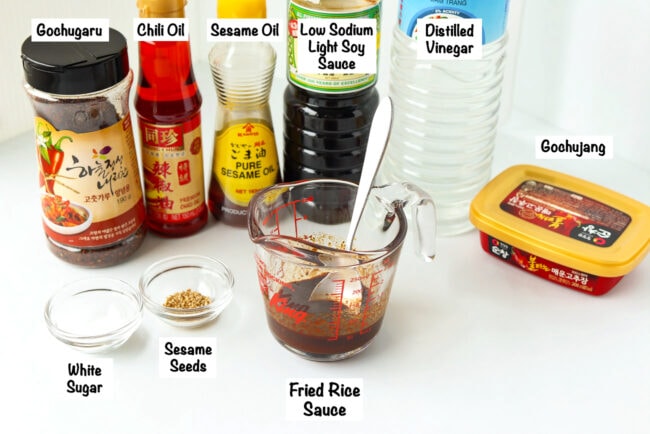
- Gochujang: Although it has a deep dark red color, gochujang is not extremely spicy. It has a spicy-sweet and smoky flavor profile. It is available in Korean and Asian supermarkets, several mainstream supermarkets, and online.
- Gochugaru: A Korean coarse hot pepper powder. Depending on the brand, the spice level will vary. Adjust the amount you use to taste. Find it in a Korean grocery store, Asian supermarket or purchase it online. If unavailable, substitute with any type of medium-hot chili powder.
- Chili Oil (optional): A pure chili oil without any seeds or flakes adds an extra kick of heat. Omit if you prefer to make this dish milder.
- Granulated White Sugar Replacement: I used Lakanto Monkfruit Sweetener which is a sugar-free alternative to granulated white sugar. It’s made from monkfruit and erythritol. Feel free to use regular white sugar, honey or other sweetener of choice to taste.
Keep in Touch!
Subscribe to get new posts via email:
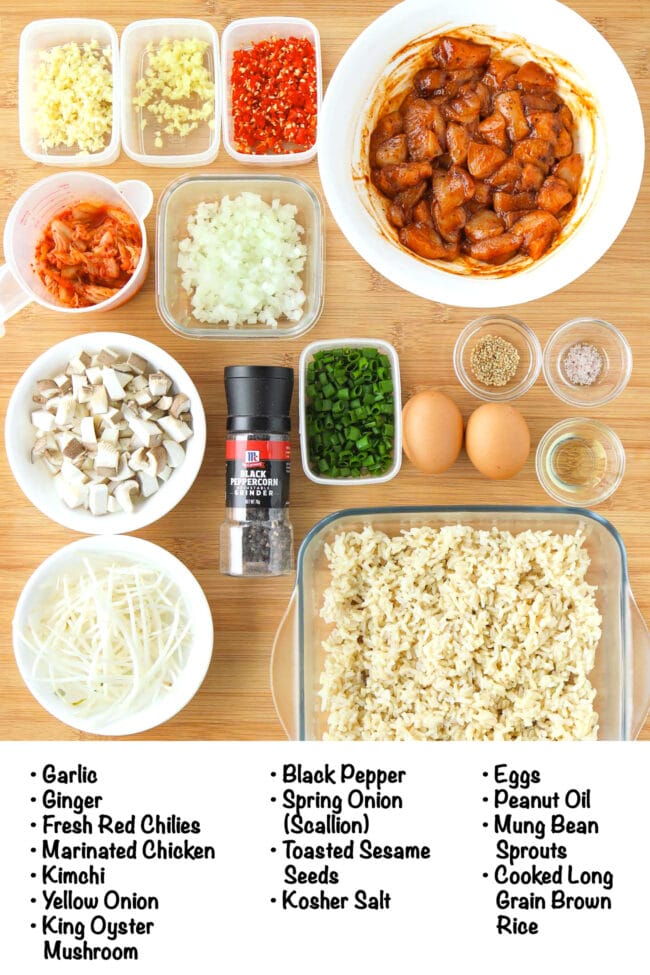
- Chicken Marinade: I used bite-sized pieces of boneless and skinless chicken breasts and marinated them with gochujang, low sodium light soy sauce, Korean sake (cooking wine), black pepper, kosher salt and sesame oil. The Korean sake helps flavor and tenderize the meat. Substitute with chicken stock if unavailable. Or you can omit it if you prefer not to cook with alcohol.
- Aromatics & Veggies: I used yellow onion, spring onion, garlic, ginger, king oyster mushroom and mung bean sprouts. See ‘Variations’ section below if you’d like some ideas for other fried rice friendly veggies that can be used.
- Fresh Red Chilies: I used Thai Bird’s Eye red chilies but any small hot red chilies will work. Adjust the quantity to taste depending on your heat level preference or omit for a milder kimchi fried rice.
- Kimchi: Kimchi is a Korean spicy fermented cabbage that come in jars, cans and packages. It’s typically made with cabbage, radish, sometimes carrots, as well as plenty of other seasonings such as fish sauce, gochugaru, garlic and ginger. You can find it in the fridge section of large mainstream supermarkets that are well-stocked with international ingredients. It’s also available in Asian and Korean supermarkets. Depending on the brand and how old the kimchi is, the acidity level and sourness will vary.
- Kimchi Juice: This is the liquid in the bottom of the jar/package of kimchi. It has plenty of flavor and is a key ingredient for making kimchi fried rice. However, your jar may not always have a lot of kimchi juice especially if you make kimchi fried rice very often. To combat this, I add distilled white vinegar to the fried rice sauce to deliver the signature tangy flavors.
- Peanut Oil: Or use any other neutral cooking oil with a high smoke point.
- Eggs: Kimchi fried rice is incomplete without a fried egg on top!
- Cooked Long-Grain Brown Rice: I used cooked long-grain Thai Jasmine brown rice. However, feel free to use Thai jasmine white rice, or any medium or short-grain cooked rice. Day-old or even 2 day old chilled rice from the fridge works best for fried rice.
Full ingredient list and amounts are in the recipe card below.
How to Make Kimchi Fried Rice with Chicken
- Cook the eggs. Fry both eggs in a little oil in a large nonstick wok (or small frying pan) until the whites have set and the yolk is cooked to your liking. Transfer to a clean plate and set aside.
- Stir-fry the aromatics. Add more oil to the wok and stir-fry the yellow onion, spring onion white and light green parts until translucent. Then add the garlic, ginger and red chilies and stir-fry until fragrant.

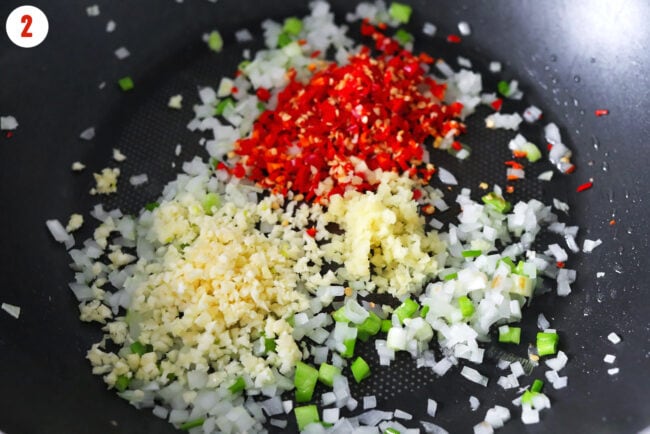
- Cook the chicken: Spread everything out to the edges of the wok and add the marinated chicken in the center. Allow to sear for a minute, then flip and sear the other side for another couple of seconds before stir-frying to combine with everything else.
- Add the mushrooms. Stir-fry to combine with everything until slightly softened.
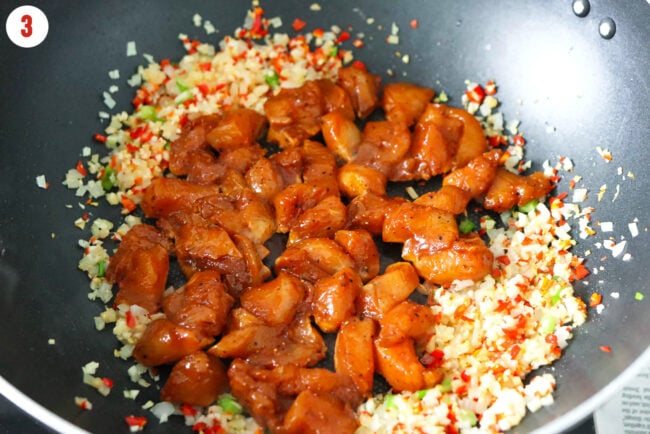
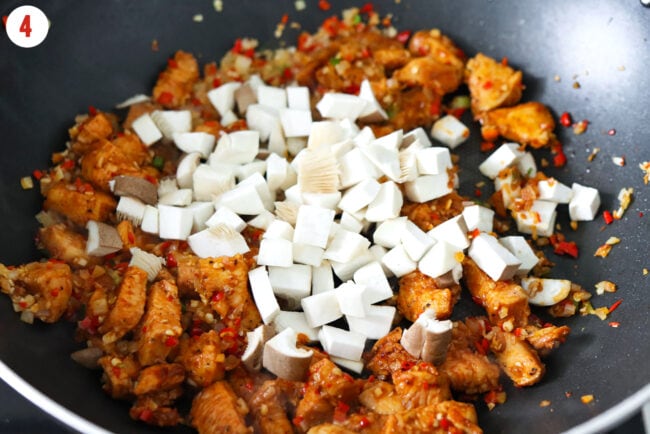
- Add the kimchi. Make a well in the center of the wok again and add the kimchi and kimchi juice. Stir-fry in the center of the wok briefly, then toss to combine with everything.
- Add the rice and sauce. Stir-fry using a scooping motion until everything is evenly coated in the sauce. Allow the fried rice to sit in the wok for a few seconds to help it “fry” instead of become mushy.
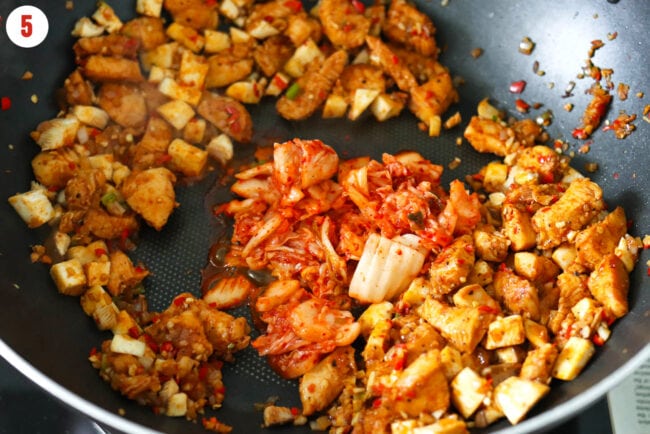
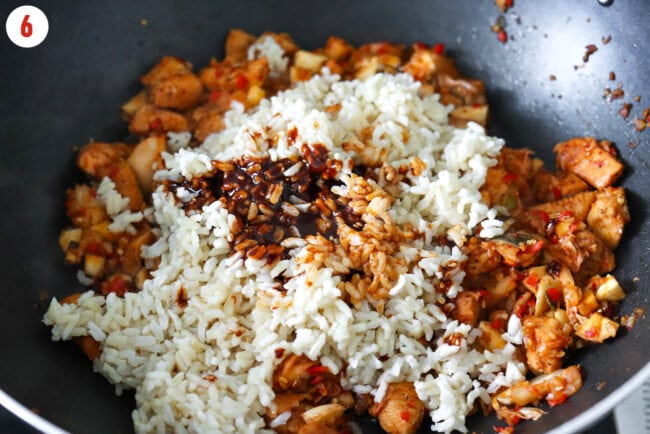
- Season with black pepper and kosher salt. Stir-fry to combine.
- Toss through spring onion greens. Add most of the spring onion dark green parts (reserve some for garnish) and mung bean sprouts. Toss until the bean sprouts have slightly softened, then switch off the heat.
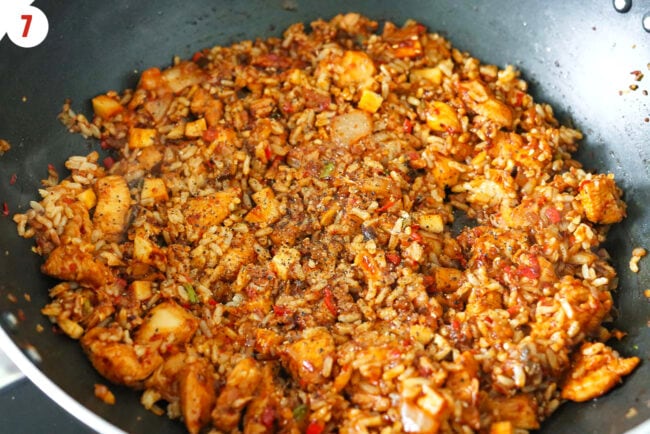
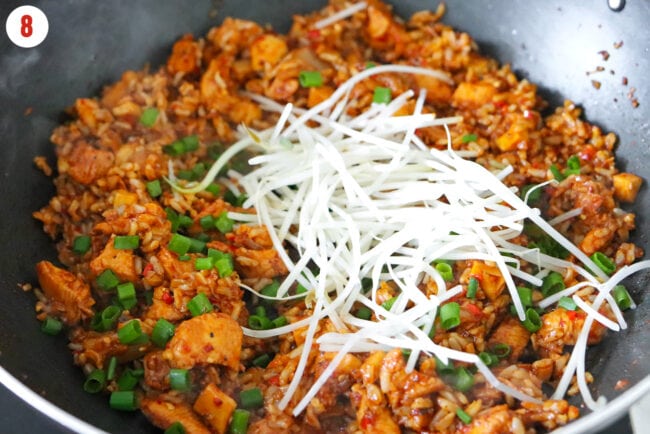
- Serve! Divide the fried rice evenly onto plates and garnish with the reserved spring onion and toasted white sesame seeds. Top each plate with a fried egg and serve immediately!
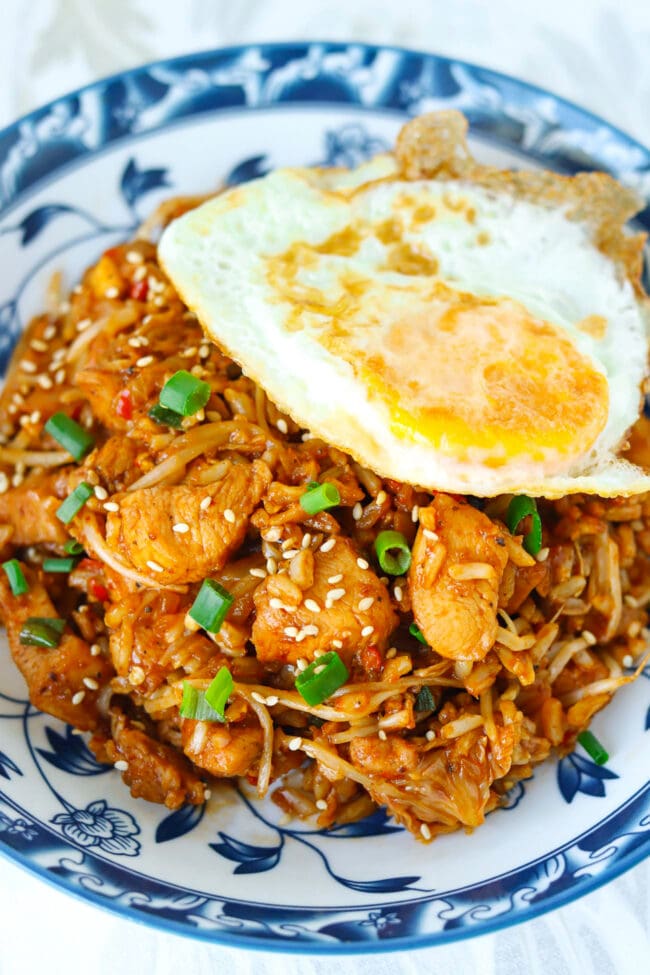
Full detailed instructions are in the recipe card below.
Cook’s Tips
- Prepare all the ingredients before you start cooking. This kimchi fried rice is ready in minutes. Prepare everything and have all the ingredients by the side of your wok before you switch on the heat and start cooking.
- Cut the kimchi using kitchen shears. Use kitchen shears to cut the kimchi into smaller pieces directly in a measuring cup or bowl instead of chopping it on a chopping board. This way none of the kimchi juice gets wasted on the board.
- Use day-old chilled rice. Cooked day-old or even 2-day old rice works best for making fried rice. It has less moisture than freshly cooked rice after sitting in the fridge overnight and it’s less likely to become mushy in the wok.
- Adjust the spice level to taste. Customize the spice level in this fried rice by using less or more gochujang, gochugaru and fresh red chilies depending on your heat level preference.
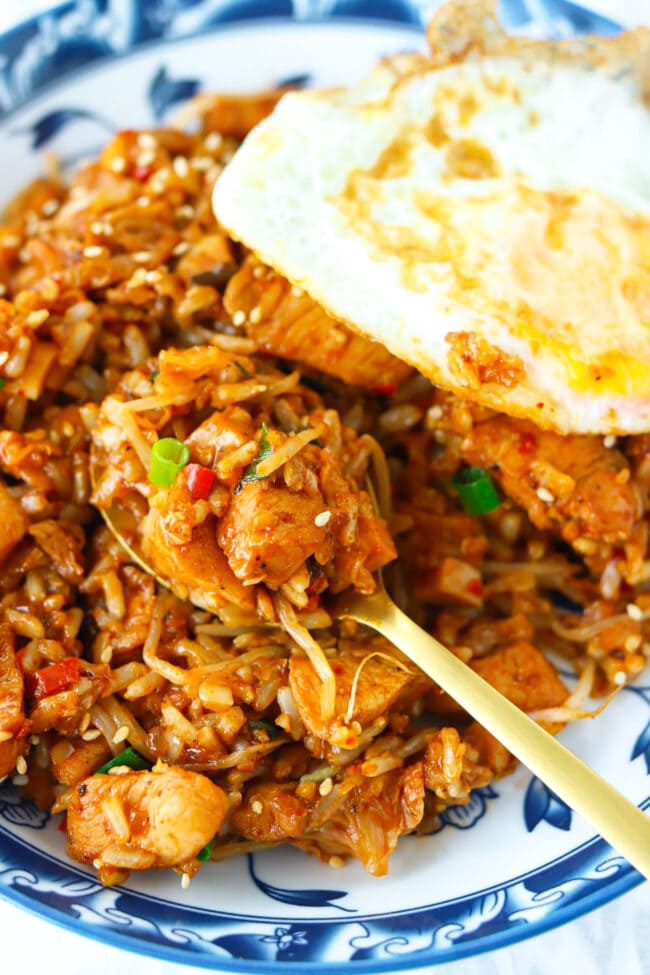
Variations
- Use a bag of frozen veggies or other veggies. A cup of bagged frozen vegetables with carrots, corn and green peas would work well in this kimchi fried rice. Other fresh veggies options are finely sliced carrots, chopped napa cabbage (Chinese cabbage/wom bok), snow peas, sugar snap peas, diced brown button mushrooms or other mushroom varieties such as enoki, cremini, shiitake, etc.
- Use a different protein. Thinly sliced pork belly or beef (shabu shabu/hot pot style slices), bacon, spam, boneless and skinless chicken thighs, or shrimp/prawns would taste great in this kimchi fried rice.
- Make it vegetarian/vegan. Use vegan kimchi without any seafood ingredients. For the protein, crispy pan-fried tofu cubes or other plant-based meat substitute can be used instead of chicken.
- Make it gluten-free. Use a gluten-free gochujang such as Wholly gochujang or Sempio gluten free gochujang, kimchi, and soy sauce (or tamari).
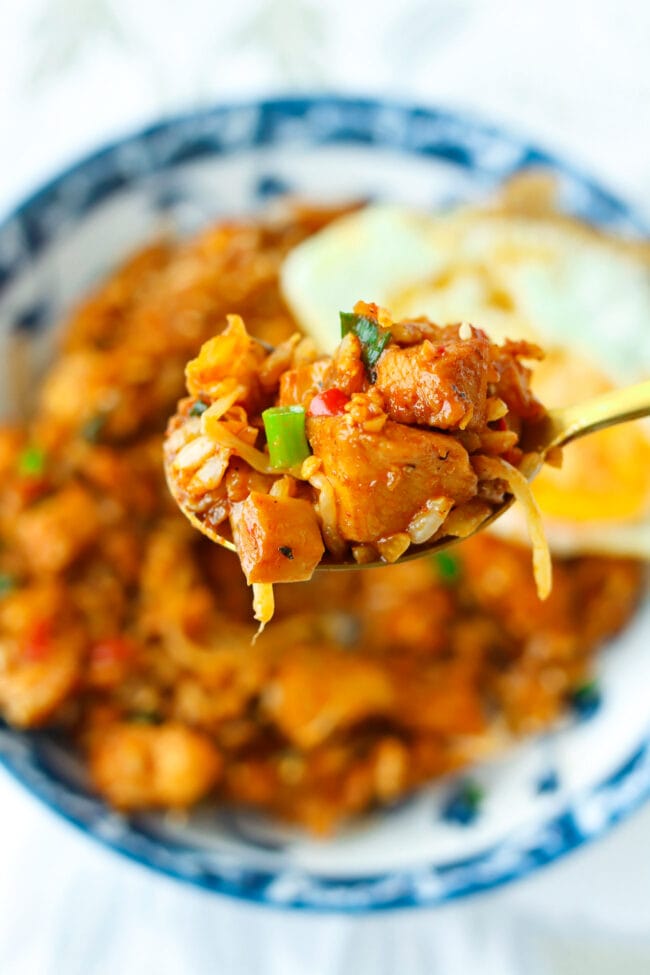
FAQs
Kimchi fried rice is often topped and served with fried egg with a runny egg yolk. However, you can cook the egg until the yolk is set to your liking.
It is slightly tangy and spicy and full of savory umami notes. Kimchi, a fermented vegetable dish often made with cabbage and/or radish, carrots, seaweed and various spices and seasonings adds sour flavors to this savory fried rice. Gochujang, gochugaru and fresh red chilies gives the fried rice spicy and smoky notes.
With rice, chicken, egg and veggies, this kimchi fried rice with chicken makes a well-balanced and filling meal on its own. However, you are welcome to add additional veggies and meat such as cooked bacon or spam if you like. You can also serve this kimchi fried rice with Korean banchan (vegetable side dishes) such as a spicy cucumber salad, seasoned mung bean sprouts, stir-fried zucchini, steamed eggplants, etc. Check out this list of recipes of 15 Korean Vegetable Side Dishes for more ideas.
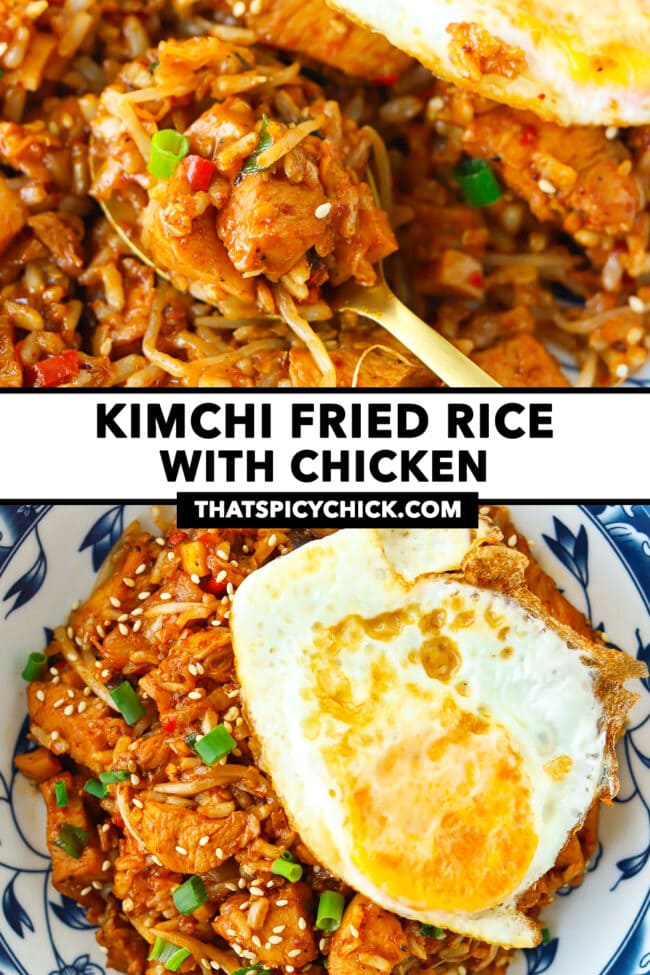
MADE THIS RECIPE? If you make this recipe, leave a comment below and let me know how you liked it! Take a photo and tag it with @thatspicychick on Instagram and hashtag it #thatspicychick and I’ll be sure to share your masterpiece!
STAY CONNECTED! You can also follow me on Pinterest, Facebook or Instagram. Sign up for my email list to get my latest recipe in your inbox weekly!
More Korean and Korean-Inspired Recipes
Kimchi Fried Rice with Chicken
Easy to make in 30 minutes and full of BIG and BOLD flavors, this Kimchi Fried Rice with Chicken is made with savory and spicy chicken pieces, kimchi, fragrant aromatics, veggies and the most delicious gochujang infused spicy, smoky, and tangy sauce with a hint of sweetness!
- Prep Time: 15
- Cook Time: 15
- Total Time: 30 minutes
- Yield: 2 1x
- Category: Dinner
- Method: Stir-fry
- Cuisine: Korean
Ingredients
Chicken Marinade:
- 15 grams / ½ TBLS Gochujang (Korean chili pepper paste – note 1)
- ½ TBSP Low Sodium Light Soy Sauce
- ½ TBSP Korean Sake (cooking wine, optional, substitute with chicken stock or omit)
- ¼ TSP ground freshly cracked Black Pepper
- ⅛ TSP Kosher Salt
- ½ TSP Sesame Oil
- 250 grams / 8.8 ounces Chicken Breast, boneless, skinless – cut into bite-sized pieces
Sauce:
- 30 grams / 1 TBSP Gochujang
- ½ TBSP Low Sodium Light Soy Sauce
- ½ TBSP Distilled White Vinegar
- ½ TSP Sesame Oil
- ½ TSP Chili Oil (optional – pure chili oil without flakes/seeds), to taste
- ½ TSP Gochugaru (Korean red pepper powder – note 1), to taste
- ½ TSP Toasted White Sesame Seeds
- 1 TSP Granulated White Sugar Replacement, to taste (or use regular white sugar or other sweetener of choice – note 2)
Kimchi Fried Rice:
- 50 grams / ¼ medium Yellow Onion – finely chopped
- 20 grams / 1 medium Spring Onion – finely chopped, white and light green parts separated from dark green parts
- 18 grams / 3 Garlic cloves – minced
- 8 grams / 1 TBSP minced Ginger
- 20 grams / 4-6 fresh Red Chilies (I used Thai Bird’s Eye but any small hot red chilies will work), to taste* (note 3)
- 80 grams / 1 medium King Oyster Mushroom – diced
- 90 grams / ½ cup Kimchi + 1 TBSP Kimchi Juice (liquid from the jar) – chopped or cut with kitchen shears
- 50 grams / ≈ ½ cup Mung Bean Sprouts – rinsed with cold water, drained
- 1 TSP + ½ TBSP Peanut Oil (or any other neutral cooking oil with a high smoke point), divided
- 2 large Eggs
- 240 grams / 1.5 cups cooked Thai Jasmine Brown Rice, day-old, chilled (100 grams / 3.5 ounces uncooked weight – note 4)
- ¼ TSP freshly cracked Black Pepper
- ⅛ TSP Kosher Salt
- To Serve: Reserved spring onion dark green parts, toasted white sesame seeds
Instructions
Prep:
- Marinate the chicken: Combine the gochujang, low sodium light soy sauce, Korean sake (if using), black pepper, kosher salt and sesame oil in a medium sized bowl. Mix until combined well. Cut the chicken into bite-sized pieces and add to the bowl. Mix until the chicken is evenly coated in the marinade, set aside.
- Make the sauce: Mix together the gochujang, low sodium light soy sauce, distilled white vinegar, sesame oil, chili oil (if using), gochugaru, toasted white sesame seeds and white sugar replacement in a small measuring cup or bowl until evenly combined.
- Prepare the fresh ingredients: Chop the yellow onion, spring onion (separate the white and light green parts from the dark green parts), garlic, ginger, red chilies and king oyster mushroom as indicated in the ‘ingredients’ section. Spoon the kimchi and kimchi juice into a small measuring cup or bowl and use kitchen shears to cut the kimchi into small pieces. Rinse and drain the mung bean sprouts.
Kimchi Fried Rice with Chicken:
- Cook the eggs: Heat 1 teaspoon peanut oil in a large nonstick wok (or use a small frying pan) over medium heat. Once hot, crack the eggs into the pan. Cook for 1-2 minutes or until the whites have set. Flip and cook for another 1-2 minutes or until the yolk is cooked to your liking. Transfer to a clean plate and set aside. (Note: Feel free to fry one side only if you prefer a runny egg yolk.)
- Stir-fry the aromatics: Add the remaining ½ tablespoon of oil to the wok and heat over high heat. Add the yellow onion, spring onion white and light green parts and sauté for 15-20 seconds until translucent. Add the garlic, ginger and red chilies and stir-fry for 20-30 seconds until fragrant.
- Cook the chicken: Spread everything out to the edges of the pan and add the marinated chicken in the center of the wok. Allow to sear for 1 minute, then flip and sear for another 20-30 seconds. Stir-fry to combine with everything else.
- Add the mushrooms and kimchi: Add the diced mushroom and stir-fry for a minute to combine with everything until slightly softened. Make a well in the center of the wok again and add the kimchi and kimchi juice. Stir-fry in the center of the wok for 10 seconds, then toss to combine with everything.
- Add the rice and sauce: Add the cooked rice and pour the stir-fry sauce on top. Stir-fry using a scooping motion until everything is evenly coated in the sauce.
- Season: Season with ¼ teaspoon black pepper and ⅛ teaspoon kosher salt and stir-fry to combine.
- Toss through spring onion greens: Add most of the spring onion dark green parts (reserve some for garnishing) and mung bean sprouts. Toss for 15-20 seconds until the bean sprouts have slightly softened, then switch off the heat.
- To Serve: Divide the fried rice evenly onto two plates and garnish with the reserved spring onion and toasted white sesame seeds. Top each plate with a fried egg and serve immediately.
Notes
- Gochujang and Gochugaru. Gochujang is a fermented Korean chili pepper paste that comes in small tubs. Although it has a deep dark red color, it’s not extremely spicy. It has a spicy-sweet and smoky flavor profile. Gochugaru is a Korean hot red pepper powder. Both are available in Korean and Asian supermarkets, in several mainstream supermarkets, and online. Gochugaru can come in varying heat levels depending on the brand. Adjust the quantity you use to taste or substitute with any type of medium-hot chili powder.
- Granulated White Sugar Replacement: I used Lakanto Monkfruit Sweetener which is a sugar-free alternative to granulated white sugar. It’s made from monkfruit and erythritol. Feel free to use regular white sugar, honey or other sweetener of choice to taste.
- Fresh Red Chilies: Use any hot red chilies that are easily available to you. Adjust the quantity to taste depending on your heat level preference or omit for a milder kimchi fried rice.
- Thai Jasmine Brown Rice. Feel free to use long-grain Thai jasmine white rice, or any medium or short-grain cooked rice. Day-old or even 2-day old chilled rice from the fridge works best for fried rice. It has less moisture than freshly cooked rice after sitting in the fridge overnight. It’s less likely to become mushy in the wok.
- Storing and reheating leftovers: Store leftover kimchi fried rice in a sealed airtight container in the fridge for up to 3 days. Reheat in the microwave for on high 2-3 minutes, mixing halfway in between, until hot throughout. I recommend frying and topping with the egg just before serving. Or if you fry the eggs in advance, reheat them separate from the fried rice in the microwave on high for 20-30 seconds.
- See the ‘Variations’ section in the post above if you’d like to customize this kimchi fried rice.
Nutrition
- Serving Size: 1/2 of recipe
- Calories: 632
- Sugar: 14.3g
- Sodium: 1849.8mg
- Fat: 20.9g
- Saturated Fat: 4.3
- Unsaturated Fat: 16.5g
- Trans Fat: 0.1
- Carbohydrates: 66.7g
- Fiber: 5.3g
- Protein: 44.8g
- Cholesterol: 277.3mg
This post may contain affiliate links. We are a part of the Amazon Services LLC Associates Program, an affiliate advertising program designed to provide a means for us to earn a small commission (at no extra cost to you) by linking to Amazon.com and affiliated sites. The nutritional information provided is approximate and can vary based on several factors. It should only be used as a general guideline. For more information, please see our Disclosure.

